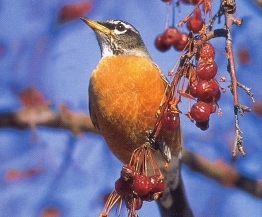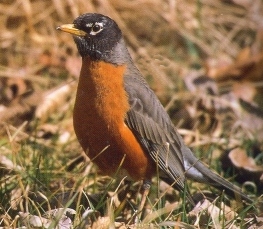|

Large, familiar North
American thrush, gray-brown upperparts, rich red-brown breast, and white
lower belly and undertail coverts. Head appears black with white splotches
surrounding the eyes, and throat is white with black streaks. Swift,
direct flight on rapidly beating wings.
The adult American
Robin has gray-brown upperparts, a rich red-brown breast and a white
lower belly.
The head is dark gray-brown with white splotches around the eye and
a dark brown streaked throat.
|
AMERICAN
ROBIN
Turdus migratorius
PASSERIFORMES
Thrushes (Turdidae)
Range
and Habitat
Breeds from Alaska east to Newfoundland and south to California, Texas,
Arkansas, and South Carolina.
Usually
spends winters north to British Columbia and Newfoundland. Preferred
habitats include towns, gardens,
open woodlands, and agricultural lands.
SOUND:
"cheerily cheer-up cheerio"
 
During
breeding season, male American Robins grow black feathers on their heads
to attract females. Once the mating season is over, these feathers are
lost.
These birds have been observed wading belly deep
in water to catch small fish.
There is a Crayola crayon named Robin’s Egg Blue.
A group of robins are collectively known as a "worm" of robins.
The
American Robin has been found to be native to Mexico, Canada, Cuba,
Bermuda, Guatemala and the Bahamas. It has also been seen in other countries
such as Haiti, Ireland, Norway, Iceland and Puerto Rico. The range of
the American Robin is quite extensive, reaching up to 16 million kilometers.
There is not any current concern regarding the possible population decline
of the American Robin due to the fact that the global population is
so large, around 320 million.
|